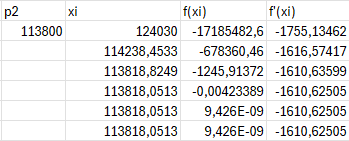I am currently working on a project to calculate and finally build to get multiple fermentation tanks ( 10+)the biogas to 1 gas upgrader via piping to make greengas. This will be done under low pressure and I am now running into a particular problem. I am trying to make a standard fill-in sheet to quickly calculate what the pressure loss is and I have also figured out that the most convenient way is to calculate it back and thus start from the upgrader back to the fermentation tanks.
I currently use this formula ∆P pipeline=p1*(1-√(1-((λ L)/D ∑ζ)*(Z T p0 ρ0 vo^2)/(Z0 T0 P1^2))
I would like a pressure of 125 mbarg at the uprader and would like to use this forum module to calculate p1 and ΔP pipeline at the same time to make an automatic schedule and work back. Do you guys think this is possible and if I need to use some more formulas please let me know, thanks in advance.
In which:
Δp = Dynamic pressure difference [Pa]
p1 = Absolute pressure at the beginning of pipe section [Pa]
λ = Coefficient of resistance [m].
L = Length of pipe section [m]
D = Interior diameter of pipe section [m]
ζ = Specific resistance of fitting or appendage [-]
Z = Compressibility factor of gas at p and T [-]
T = Temperature of gas [K]
T0 = Normal temperature [273.15 K]
p0 = Normal pressure [101325 Pa]
ρ0 = Specific gravity at T0 and p0 [kg/m3]
v0 = Gas velocity p0 and T0 [m/s]
Z0 = Compressibility factor of gas at p0 and T0 [-]
This assumes that there are no tight bends, tees or narrows in the pipe section. Therefore, ζ = 0. Also, for λ, the following equation applies
I currently use this formula ∆P pipeline=p1*(1-√(1-((λ L)/D ∑ζ)*(Z T p0 ρ0 vo^2)/(Z0 T0 P1^2))
I would like a pressure of 125 mbarg at the uprader and would like to use this forum module to calculate p1 and ΔP pipeline at the same time to make an automatic schedule and work back. Do you guys think this is possible and if I need to use some more formulas please let me know, thanks in advance.
In which:
Δp = Dynamic pressure difference [Pa]
p1 = Absolute pressure at the beginning of pipe section [Pa]
λ = Coefficient of resistance [m].
L = Length of pipe section [m]
D = Interior diameter of pipe section [m]
ζ = Specific resistance of fitting or appendage [-]
Z = Compressibility factor of gas at p and T [-]
T = Temperature of gas [K]
T0 = Normal temperature [273.15 K]
p0 = Normal pressure [101325 Pa]
ρ0 = Specific gravity at T0 and p0 [kg/m3]
v0 = Gas velocity p0 and T0 [m/s]
Z0 = Compressibility factor of gas at p0 and T0 [-]
This assumes that there are no tight bends, tees or narrows in the pipe section. Therefore, ζ = 0. Also, for λ, the following equation applies

